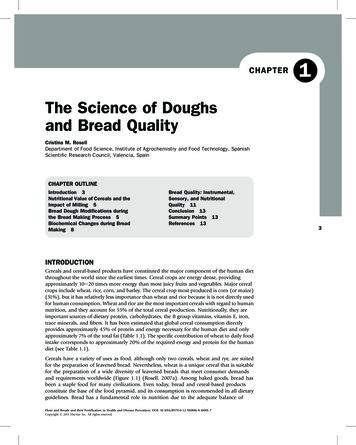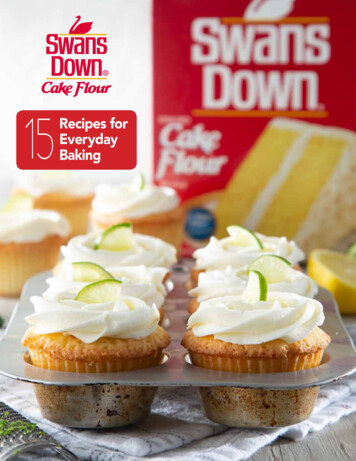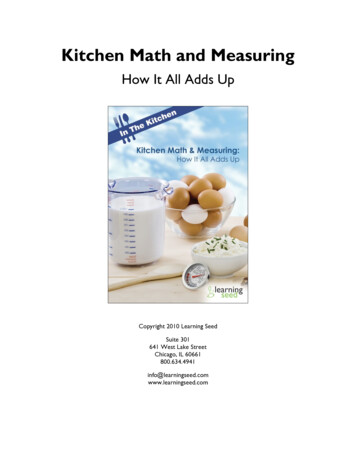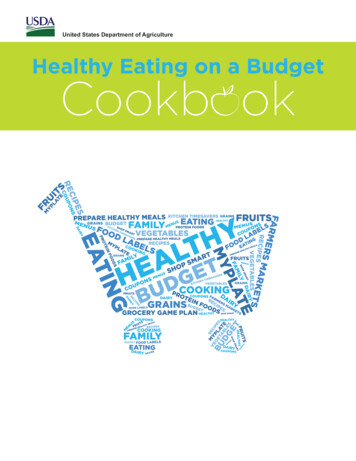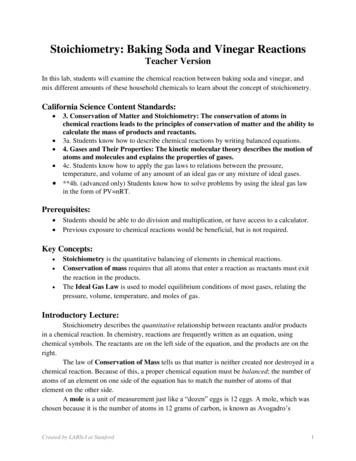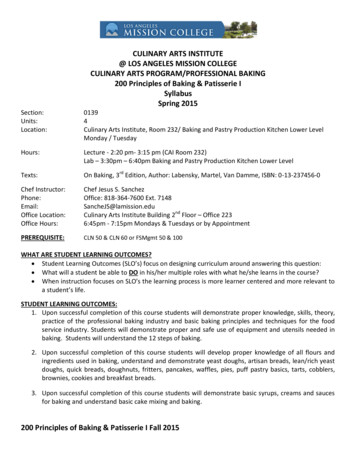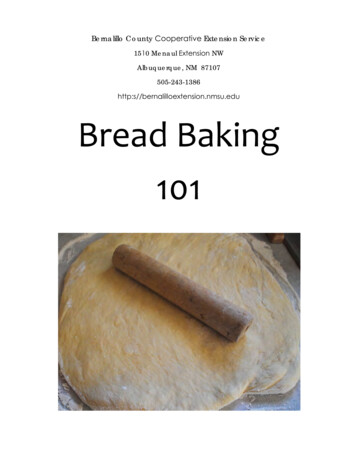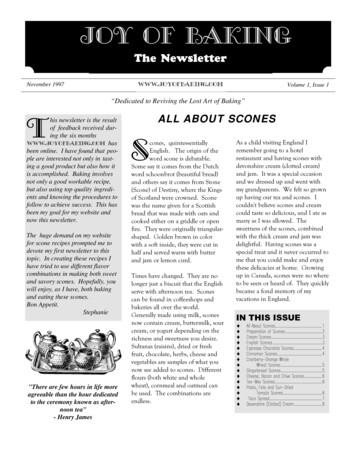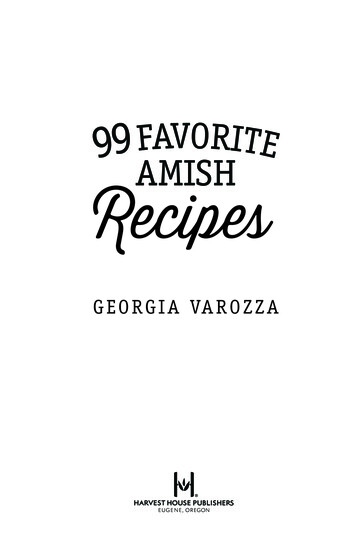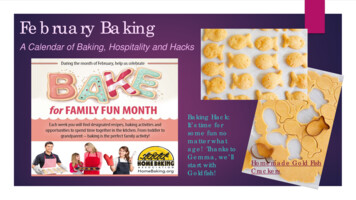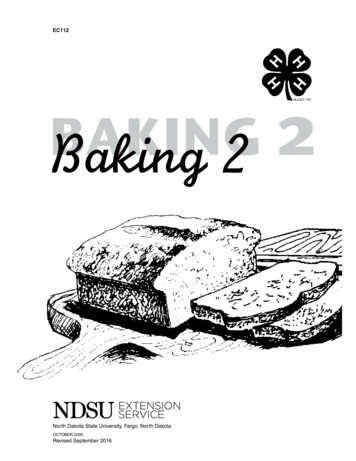
Transcription
EC112BAKING2Baking 2North Dakota State University, Fargo, North DakotaOCTOBER 2005Revised September 2016
AcknowledgmentsThe New Mexico 4-H Curriculum Review Committee revised this project in 2001.Members of the committee were:Shelly Porter, Colfax County Extension Home EconomistOwida Franz, Union County Extension Home EconomistBetty McCreight, Lincoln County Program Director-Home EconomistMargaret Dines, Grant County Extension Home EconomistDarlene Dickson, 4-H/Youth SpecialistLayout by:Ana Henke, Media Specialist Assistant, Agricultural Communications, New Mexico State UniversityAdapted in North Dakota by the 4-H Healthy Livestyles Programming Commitee:Marcia Hellendsaas, McKenzie and Dunn County Extension Agent - Nutrition, Food Safety and HealthGail Slinde, Ward County Extension Agent - 4-H Youth DevelopmentKaylyn Anderson, LaMoure County Extension Agent - 4-H Youth Development/Nutrition EducationMacine Lukach, Cavalier County Extension Agent - Nutrition, Food Safety and HealthHeather Hagen, Former Cass County 4-H MemberDeb Hagen, Cass County 4-H Volunteer LeaderJane Edwards, Extension Nutrition Specialist, NDSU Department of Health, Nutrition andExercise SciencesJulie Garden-Robinson, Extension Food and Nutrition Specialist, NDSU Department of Health,Nutrition and Exercise SciencesCarrie Stark, 4-H Youth Development Specialist, NDSU Extension Service, Center for 4-H YouthDevelopmentRevised June 2016 by Julie Garden-Robinson, Extension Food and Nutrition Specialist2
ContentsIntroduction . 4Eating Well . 5Getting Ready to Bake . 10Let’s Talk About Ingredients .11Let’s Look at Equipment .14More Baking Terms .16Let’s Bake Quick-loaf Breads .17Nut Bread . 18Cranberry and Blueberry Nut Bread . 18Banana Nut Bread .19Zucchini Bread . 20Standards of Quality for Quick-loaf Breads . 21How to Judge Baked Products: Quick-loaf Breads. 22Let’s Bake Coffeecake . 23Quick Coffeecake . 23Fruit-filled Coffeecake . 24Standards of Quality for Coffeecakes . 25How to Judge Baked Products: Coffecakes. 26Let’s Bake Cookies and Bars . 27Brownies . 28Chocolate Chip Applesauce Brownies . 29Cranberry Granola Bars . 29Butterscotch Bars . 30Jam Thumbprint Cookies .31Peanut Butter Blossom Cookies . 32Brown Sugar Nut Rounds . 33Standards of Quality for Cookies . 34How to Judge Baked Products: Cookies and Bars. 35Let’s Bake Gingerbread . 36Let’s Bake Cornbread .37Other Activities . 38Baking Record Form . 423
IntroductionThe 4-H Baking II project is designed to build upon basicconcepts learned in the Baking I project. In Baking II, youwill learn how to make more advanced types of quickbreads and cookies. You also will review basic measuring techniques and baking terms, and demonstrate the proper way to use baking equipmentand utensils when making the recipes in thisproject.You will learn: How to make new quick breads, including quickloaf breads, coffeecake, cornbread and gingerbread How to make different types of cookies, including brownies, bars, slice-and-bakerefrigerator cookies and shaped cookiesTo complete this project you should: Attend 4-H club meetings and baking project meetings as available in your county Give a demonstration or presentation to teach others what you have learned fromthis project Participate in citizenship activities Develop leadership skills through your club and county activities Keep records of your project work and accomplishments Make and exhibit baked products at your county fair or achievement dayExhibit Ideas*Basic nut breadBanana nut breadZucchini breadQuick coffeecakeFruit-filled coffeecakeBrown sugar nut cookiesGingerbreadJam thumbprint cookiesPeanut butter blossom cookiesPlain browniesCornbreadButterscotch bars*Follow 4-H exhibit guidelines4
Eating WellMyPlate Speaks“MyPyramid” has been rebuilt and it’s now aplate! Here’s what the colors stand for:Let’s look at some of the other messages this newsymbol is trying to send:orange - grainsgreen - vegetablesred - fruitsblue - dairy foodspurple - protein foodsBalancing Calories Enjoy your food, but eat less. Avoid oversized portions.The U.S. Department of Agriculture (USDA)wanted an easier way to remind people to eathealthfully. MyPlate shows the five food groupsusing a familiar picture: a place setting with aplate, cup and fork.Foods to Increase Make half your plate fruits and vegetables. Make at least half your grains whole grains. Switch to fat-free or low-fat (1%) milk.Foods to Reduce Compare sodium in foods such as soup, breadand frozen meals. Choose foods with lowernumbers. Drink water instead of sugary drinks.Make it personal.Through the USDA’s MyPlate website(www.choosemyplate.gov), you can getpersonalized recommendations about the mix offoods you need to eat and how much you shouldbe eating.5
How Much Do I Need to Eat?FruitsEveryone wants to know how much he orshe should eat to stay healthy. That’s a trickyquestion, though. It depends on your age,whether you’re a girl or boy, and how active youare. Kids who are more active burn more calories,so they need more calories. But we can give yousome estimates for how much you need of eachfood group.Sweet, juicy fruit definitely is part of a healthy diet.Here’s how much you need: 4- to 8-year-olds need 1 cup to 1½ cups of fruiteach day. 9- to 13-year-old girls need 1½ cups of fruit eachday. 9- to 13-year-old boys need 1½ cups of fruit eachday.GrainsDairy FoodsGrains are measured in ounce equivalents. Whatare they? Ounce equivalents are just another wayof showing a serving size.Dairy foods are rich in calcium to build strongbones to last a lifetime. 4- to 8-year-olds need 1 to 2 cups of milk (or othercalcium-rich food) each day. 9- to 13-year-old girls need 3 cups of milk(or other calcium-rich foods) each day. 9- to 13-year-old boys need 3 cups of milk(or other calcium-rich foods) each day.Here are ounce equivalents for common grainfoods. An ounce equivalent equals:1 piece of bread½ cup of cooked cereal, such as oatmeal½ cup of rice or pasta1 cup of cold cerealIf you want something other than milk, you cansubstitute yogurt, cheese or calcium-fortifiedorange juice — just to name a few. 4- to 8-year-olds need 4 to 5 ounceequivalents each day. 9- to 13-year-old girls need 5 ounceequivalents each day. 9- to 13-year-old boys need 6 ounceequivalents each day.Protein FoodsThese foods contain iron and lots of otherimportant nutrients. Like grains, these foods aremeasured in ounce equivalents.And one last thing about grains: Make at leasthalf your grain food choices whole grains, suchas 100 percent wheat bread, brown rice andoatmeal.An ounce equivalent of this group would be:1 ounce of meat, poultry or fish¼ cup cooked dry beans1 egg1 tablespoon of peanut buttera small handful of nuts or seedsVegetablesOf course, you need your vegetables, especiallythose dark green and orange ones. But how muchis enough? Vegetable servings are measuredin cups. 4- to 8-year-olds need 3 to 4 ounceequivalents each day. 9- to 13-year-old girls need 5 ounceequivalents each day. 9- to 13-year-old boys need 5 ounceequivalents each day. 4- to 8-year-olds need 1½ cups of veggies eachday. 9- to 13-year-old girls need 2 cups of veggieseach day. 9- to 13-year-old boys need 2½ cups of veggieseach day.Whoa! That’s a lot to swallow. The good news isthat your mom, dad and the other grownups inyour life will help you eat what you need to stayhealthy. Here’s more good news: You don’t have tobecome a perfect eater overnight.Adapted with permission fromhttp://kidshealth.org/kid/stay healthy/food/pyramid.html6
United States Department of Agriculture10tipsNutritionEducation Seriesenjoy your food,but eat less10 tips to enjoying your mealYou can enjoy your meals while making small adjustments to the amounts of food on your plate.Healthy meals start with more fruits, vegetables, grains, protein foods, and dairy. Drink and eat less sodium,saturated fat, and added sugars.16get to know the foods you eatUse the SuperTracker to find out what kinds of foodsand how much to eat and to get tips and support formaking better food choices.2Choose more vegetables, fruits, whole grains, andfat-free or 1% milk and dairy products. Cut back on foodshigh in solid fats, added sugars, and salt.Be mindful to eat slowly, enjoy the taste andtextures, and pay attention to how you feel. Usehunger and fullness cues to recognize when to eat andwhen you’ve had enough.738take your timeuse a smaller plateif you eat out, choose healthier options910compare foodsIndulge in a naturally sweet dessert dish—fruit!Serve a fresh fruit cocktail or a fruitparfait made with yogurt. For a hot dessert,bake apples and top with cinnamon.USDA is an equal opportunity provider and employer.FAT FREECheck out the Food-A-Pedia to look up and comparenutrition information for more than 8,000 foods.satisfy your sweet tooth in a healthy wayCenter for Nutrition Policy and Promotionsip smarterDrink water or other calorie-freebeverages, 100% juice, or fat-freemilk when you are thirsty. Soda and othersugar-sweetened beverages containadded sugar and are high in calories.Check and compare nutrition information aboutthe foods you are eating. Preparing food at homemakes it easier to control what is in your meals.5find out what you needGet your personalized plan by using the SuperTrackerto identify your food group targets. Compare the foodsyou eat to the foods you need to eat.Use a smaller plate at meals to help with portioncontrol. That way you can finish your entire plate andfeel satisfied without overeating.4choose to eat some foodsmore or less oftenmake treats “treats,”not everyday foodsTreats are great once in a while. Just don’t maketreat foods an everyday choice. Limit sweet treats to specialoccasions.Go to www.ChooseMyPlate.govfor more information.7DG TipSheet No. 18Revised January 2016
United States Department of Agriculture10tipsNutritionEducation Serieschoosingwhole-grain foods10 tips for purchasing and storing whole-grain foodsWhole grains are important sources of nutrients such as zinc, magnesium, B vitamins, andfiber. There are many choices available to make half your grains whole grains. But whole-grain foods should behandled with care. Over time and if not properly stored, oils in whole grains can cause spoilage. Consider thesetips to select whole-grain products and keep them fresh and safe to eat.16search the labelWhole grains can be an easy choicewhen preparing meals. Choosewhole-grain breads, breakfast cereals,and pastas. Look at the Nutrition Factslabels and ingredients lists to find choiceslower in sodium, saturated (solid) fat, and added sugars.2Buy whole-grain products that are tightly packagedand well sealed. Grains should always look and smellfresh. Also, check the expiration date and storage guidelineson the package.78Your kids can choose whole grains at school.Encourage healthier choices at home by addingwhole grains into their favorite recipes, meals, and snacks.9wrap it upWhole-grain bread is best stored at room temperaturein its original packaging, tightly closed with a quicklock or twist tie. The refrigerator will cause bread to losemoisture quickly and become stale. Properly wrappedbread will store well in the freezer.find the fiber on labelIf the product provides at least 3 grams of fiber perserving, it is a good source of fiber. If it contains 5 ormore grams of fiber per serving, it is an excellent source of fiber.10is gluten in whole grains?what’s the shelf life?Since the oil in various whole-grain floursdiffers, the shelf life varies too. Most whole-grainflours keep well in the refrigerator for 2 to 3 months and inthe freezer for 6 to 8 months. Cooked brown rice can berefrigerated 3 to 5 days and can be frozen up to 6 months.People who can’t eat wheat gluten caneat whole grains if they choose carefully.There are many whole-grain products, such asbuckwheat, certified gluten-free oats or oatmeal,popcorn, brown rice, wild rice, and quinoa that fitgluten-free diet needs.USDA is an equal opportunity provider and employer.buy what you needPurchase smaller quantitiesof whole-grain products toreduce spoilage. Most grains insealed packaging can be kept inthe freezer.kids can choose whole grainsCenter for Nutrition Policy and Promotionkeep a lid on itWhen storing whole grains from bulk bins, usecontainers with tight-fitting lids and keep in a cool,dry location. A sealed container is important for maintainingfreshness and reducing bug infestations.look for the word “whole” at thebeginning of the ingredients listSome whole-grain ingredients include whole oats,whole-wheat flour, whole-grain corn, whole-grain brownrice, and whole rye. Foods that say “multi-grain,” “100%wheat,” “high fiber,” or are brown in color may not be awhole-grain product.345check for freshnessGo to www.ChooseMyPlate.govfor more information.8DG TipSheet No. 22Revised January 2016
Why Do We Eat?Nutrients — Who Needs Them?We know everyone needs food to live.But why?Nutrients are chemical substances that yourbody gets from the food you eat. Each nutrienthas a different job to do. They all are necessary inspecific amounts, but your body knows how tohandle it all! You’re an amazing machine!Food gives you two things: Energy to move and to do things Stuff to help you grow and stay healthy Vitamin A helps you see in the dark.Just like a car needs fuel to run, your body needsfood for energy. Without energy, you couldn’trun or play. Water regulates body temperature. Calcium builds strong bones and teeth. Fat gives you energy and carries some vitaminsto where the body needs them.Besides giving you energy, food helps you growand heal. When you skin a knee or an elbow, yourbody needs to fix or replace the skin you scrapedoff. If you get sick, your body needs to fight theinfection, rebuild weak body parts and get well.Your body also keeps you from getting too hot orcold. Nutrients are the things in food that helpyour body perform all these functions. So yourbody doesn’t need just the food, it needs thenutrients in the food. Iron helps your blood carry oxygen to all partsof your body — even your toes! Protein builds and repairs muscles and otherparts of your body. Vitamin C helps heal cuts. Carbohydrates give you energy to grow, moveand do things.9
Getting Ready to BakeIn the Baking I project, you learned how to use basic kitchen equipment, measureingredients properly for success, follow kitchen and food safety rules, and getready to bake.In Review: Remember To . . .Read the recipe carefully before you begin. Make sure you read the recipe from startto finish and understand exactly what you will be doing, how to do it and abouthow much time you will need. Ask an adult to help explain steps or procedures thatyou don’t understand.Clear a work space. The less clutter, the less chance that you will make a mistakewhen baking. Make sure kitchen counters are clean and your hands are washed.Get your equipment ready. Set out all the equipment and utensils you need forthe recipe. Check pans and bowls to make sure they are the same size and type therecipe suggests.Gather all ingredients. Check the recipe’s ingredient list and gather them aroundyour work space. Remember to measure all ingredients carefully. Even smallchanges in the amount of ingredients added to a recipe or the temperature of youroven may make a bigdifference in the success of your final baked product.Ready . . . well, almost!10
Let’s Talk About IngredientsFlourSome flours are made from soft wheats, others from hard wheats,and others are a combination of both soft and hard wheat. The typeof flour affects the texture of baked products. All-purpose flour will beused in all of the recipes in this project.All-purpose flour: A blend of soft and hard wheat flours are used tomake this multipurpose flour, which can be used in a wide range ofbaked products. All-purpose flour should be stored in an airtightcontainer in a cool, dry place. To measure, stir flour with aspoon to lighten it. Gently spoon flour into a dry measuringcup. Level off the top with the straight edge of a knife ormetal spatula.SweetenersIn baking, sweeteners add flavor, tenderness and a bit of browning to baked goods. Sweeteners may be granular, as in granulatedwhite and brown sugar, or liquid, as in honey, corn syrup and molasses.White, Granulated SugarThis is the most common sweetener used in baking. It is made from sugar cane or sugar beets.Measure by spooning into a dry measuring cup and leveling the top off with the straight edgeof a knife or metal spatula.Brown SugarBrown sugar is a mixture of granulated sugar and molasses, which gives it flavor and color.Brown sugar is available in both light and dark varieties. To measure, pack firmly in a dry measuring cup and level off the top with the straight edge of a knife or metal spatula. Brown sugarsometimes can be lumpy or hard. If lumpy, press through a sieve before adding to your recipe.To quickly soften hardened brown sugar, place in a microwave-safe glass dish. Add one applewedge or one slice of white bread. Heat, covered, on high power for 30 to 40 seconds.Let stand 30 seconds; remove apple or bread and stir sugar before measuring.Powdered SugarAlso known as confectioner’s sugar, this type of sugar actually is granulated sugar that has beenmilled to a fine powder, then mixed with cornstarch to prevent lumping. Sift powdered sugarbefore using; do not substitute for granulated sugar. Lightly spoon into dry measuring cup; levelwith straight edge of a knife or metal spatula.MolassesMolasses is a thick, dark brown syrup generally made from the juice pressed from sugar caneduring refining. It mainly is used for flavoring gingersnaps and gingerbread, and also addssweetness to other baked goods. Molasses comes in light and dark varieties. To measure, pourmolasses into a liquid measuring cup until you reach the desired measurement.11
FatsMany baked products rely on fats for flavor and tenderness.ShorteningShortening is a solid fat that is made from vegetable oils. To measure, press firmly intoa dry measuring cup with a spoon or rubber scraper, making sure to press out any airbubbles. Level the excess shortening off with the straight edge of a knife or metal spatula.Shortening is packaged in sticks that are marked by tablespoon or cup measurements.Use a knife to cut on the mark that shows the amount you need. Plain and butter-flavoredtypes are available. Shortening should be stored at room temperature.ButterButter is made from fresh or soured creamand may be purchased unsalted or salted,which adds flavor and increases the shelflife of the butter. Butter is stored in therefrigerator and should be kept covered toretain its flavor and keep it from absorbing other food odors. Since butter mostoften is packaged in stick form, it is easy tomeasure by checking the markings on thewrapper and cutting the amount you needwith a knife. If the wrapper is not marked,measure it as you would shortening.Measuring Butter2 cups four sticks 1 pound1 cup two sticks ½ pound½ cup one stick ¼ pound or 8 tablespoonsa cup 5a tablespoons¼ cup ½ stick 4 tablespoonsMargarineMargarine contains fat, water, milk solids and salt. It was developed in the late 1800s asa substitute for butter. For best results when baking, use margarine that has at least 80percent vegetable oil or fat. Lighter margarines, which should be used only as tablespreads, contain additional water and milk solids that may affect the quality of bakedgoods. Margarine and butter are measured in the same way. Store in the refrigerator.Vegetable OilVegetable oils generally are made from corn, soybeans, sunflower seeds or peanuts andshould be measured in a liquid measuring cup for accuracy. Do not substitute vegetable oilfor solid fats such as butter or shortening. Store at room temperature.EggsLarge eggs are needed for the recipes in this project book. If you use an egg size otherthan large, you may need to increase or decrease the number of eggs you use in the recipe.A large egg equals 1/3 cup when measured.Egg SafetyEating raw or undercooked eggs can be hazardous, especially to older people, infants,young children, pregnant women and the seriously ill. This is why eating raw cookiedough or other uncooked products containing raw eggs is not a good idea. Commercialegg products, purchased in the grocery store, are safe to use because any salmonellabacteria has been destroyed. Eggs should be stored in their carton in the refrigerator.12
Baking Powder and Baking SodaBaking powder and baking soda are leavening agents that add lightness to baked goods, causing them to “rise” by producing carbondioxide. Double-acting baking powder produces gases in two stages:first, when liquids are added and second, during baking. Bakingsoda creates carbon dioxide bubbles instantly when mixed with ingredients such as buttermilk, so recipes that use only baking soda and nobaking powder should be baked right away.MilkMilk and milk products are used in baking to provide moisture, flavorand color. They also help baking soda and baking powder begin working in baked products. Whole, low-fat and skim milk are different inthe amount of fat they contain, but can be used in baked productswithout making any changes. Whole milk may give baked productsa richer flavor than skim milk. Milk should be measured in a liquidmeasuring cup for accuracy.ButtermilkButtermilk is low-fat or skim milk with an added bacterial culture. It is thick and creamywith a bit of a sour taste. Powdered buttermilk also is available. Follow package directions formaking buttermilk. Sour milk can be made and substituted for buttermilk. To make sour milk,place 1 tablespoon lemon juice or vinegar into a liquid measuring cup and add enough milk tomake 1 cup total liquid. Let the mixture stand five minutes before using in your recipe.ChocolateDifferent types of chocolate vary in flavor and texture when melted, so be sure to usethe correct type of chocolate called for in the recipe. Store chocolate in a tightly coveredcontainer or sealed plastic bag in a cool, dry place to prevent a chocolate “bloom” or grayfilm from forming.Unsweetened Chocolate SquaresThis type of chocolate is sometimes called baking or bitter chocolate since it is unsweetenedand has no added flavoring.To melt chocolate:1. Place chocolate pieces or squares in a heavy saucepan on the lowest possible heat setting.Stir chocolate as it melts, watching carefully to avoid overheating. Or . . .2. Place chocolate pieces or squares in a microwave-safe measuring cup or bowl. Microwaveuncovered, on high (100 percent) power, for one minute; stir. Continue microwaving,10 to 20 seconds at a time, stirring between times, until chocolate is smooth.Unsweetened Cocoa PowderWhen substituting cocoa for chocolate squares, use 1/4 cup cocoa plus two teaspoons ofshortening or butter for each 1 ounce chocolate square.NutsWhole or chopped, plain or salted, nuts add a rich flavor and texture to baked products.Favorite varieties include pecans, walnuts, peanuts and almonds. You can substitute manyother varieties of nuts for a change of pace.13
Let’s Look at EquipmentYou can make good-quality products without all of the equipment listed below, but the correctequipment and utensils always make the job easier. You will want to check the equipmentin your kitchen to see what you have available to bake the products in this project. Learn toproperly and safely use the correct piece of equipment or utensil for each job.Standard Measuring CupsUse a glass or clear plastic measuring cup for liquids. Place the measuring cup on a flatsurface, then pour in the liquid until you reach the desired measurement. Always read themeasurement at eye level. Dry-ingredient measuring cups hold an exact amount and havestraight rims so you can level off the ingredients with a straight-edged knife or narrow metalspatula. They usually are made of metal or plastic. A set usually has 1/4 cup, 1/3 cup, 1/2 cupand 1 cup measures.Measuring SpoonsA set of standard-sized measuring spoons is used to measure small amounts of dry orliquid ingredients. The most common sizes are 1/4 teaspoon, 1/2 teaspoon, 1 teaspoon and1 tablespoon. Always level dry ingredients with a straight-edged knife or narrow metal spatula.When measuring a liquid, fill the spoon to the top, holding it over a separate bowl in casespilling occurs. Measuring spoons can be made of metal or plastic.Mixing BowlsYou will need bowls of different sizes to complete the recipes. A set of three nesting mixingbowls will suit most needs.SpatulasAlways level ingredients with the straight edge of a narrow metal spatula or knife. A largermetal spatula is helpful in taking baked products out of the pan or when transferring cookiesfrom one surface to another. A rubber spatula is used for scraping ingredients from the sideof mixing bowls or measuring cups.14
Cookie SheetsUse heavy-gauge, shiny aluminum cookie sheets with very low sides or no sides atall. Dark baking sheets absorb heat and may cause cookie bottoms to overbrown.Insulated baking sheets tend to heat up slowly so cookies may become pale in colorand coarse textured. However, using insulated baking sheets may lessen the chance ofoverbrowning the bottom of cookies.Baking PansWhen baking, pay attention to the size of pan the recipe recommends. The thicknessof the dough in the pan affects the texture of the finished product. A pan that is toosmall will result in a cakelike texture and may overflow; too large a pan will allow thedough to spread too thin, resulting in a dry, brittle texture. When using glass pans,reduce the temperature by 25 degrees.GraterUtensil used for grating citrus peel or zest, cheese, vegetables or other foods intosmall pieces.Wire WhiskUtensil used to beat ingredients, such as eggs, togetheruntil they are well-blended.Nut ChopperA device with blades that chops nuts into small pieces,trapping them in a glass container.Pastry BlenderUtensil with a wooden or plastic handle and several dullblades that is used to cut in or work a solid fat into dryingredients.15
More Baking TermsIf you’re a bit puzzled by a word in a recipe, check this list of baking terms for anexplanation. Here are a few of the more commonly used baking terms you learned aboutin Baking I, along with some new terms that you will be using in this project.BatterAn uncooked mixture that is thin enough to pour, usually containingeggs, flour and liquid.BeatTo mix ingredients vigorously, using a continuous circular motion.BlendTo combine two or more ingredients thoroughly. Well-blended is usedto describe ingredients that have been combined until no trace of anysingle ingredient is left.ChillTo place food in the refrigerator until cold.ChopTo cut ingredients, such as nuts, into pieces. Coarsely chopped meanslarge pieces, finely chopped means small pieces.CombineTo mix together two or more ingredients.DoughAn uncooked mixture usually containing flour, liquid and seasonings thatis soft enough to be worked with your hands, but is too stiff to pour.GrateTo rub a food against a surface of small, sharp-edged rasps to makefine particles or pieces.PreheatTo heat the oven to a certain temperature before putting food into cook. Preheat an oven for at least 15 minutes.Set AsideTo put food aside while you do something else in the recipe.SprinkleTo scatter one or more ingredients over a surface.ZestThe brightly colored outer layer of the peel of a citrusfruit, mainly lemons and oranges. It is grated to addflavor to cookies, quick breads and other recipes.16
Let’s BakeQuick-loaf BreadsUnlike yeast breads, quick breads are made with quick-acting baking powder and baking sodaand are mixed, shaped and baked all at once without waiting between steps. The biscuits,muffins and pancakes made in Baking I are all examples of quick breads. In Baking II, you willlearn to make additional quick breads — cornbread, gingerbread and quick-loaf breads.Golden Rules of Quick Bread BakingAs suggested by their name, quick breads are a breeze to make if you follow a few golden rulesof quick bread baking. Measure ingredients accurately. Avoid mixing the bat
Dairy foods are rich in calcium to build strong bones to last a lifetime. 4- to 8-year-olds need 1 to 2 cups of milk (or other calcium-rich food) each day. 9- to 13-year-old girls need 3 cups of milk (or other calcium-rich foods) each day. 9- to 13-year-old boys need 3 cups of milk (or other calcium-rich foods) each day.
